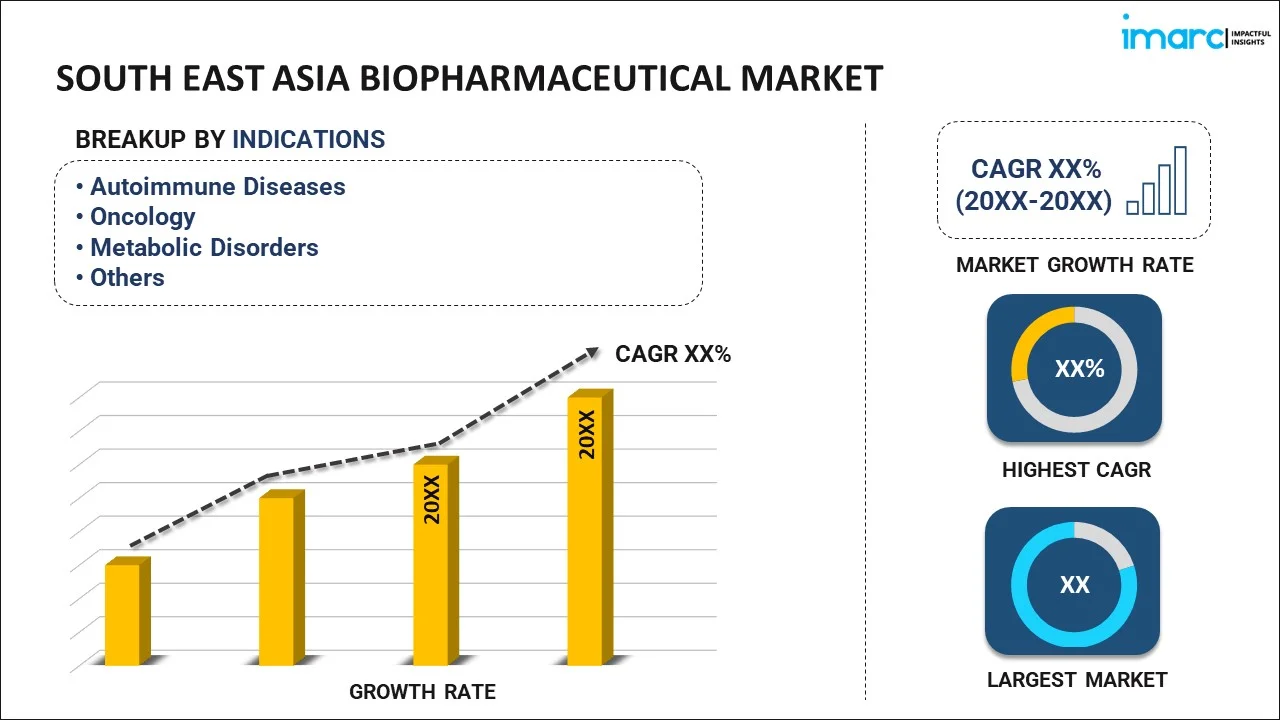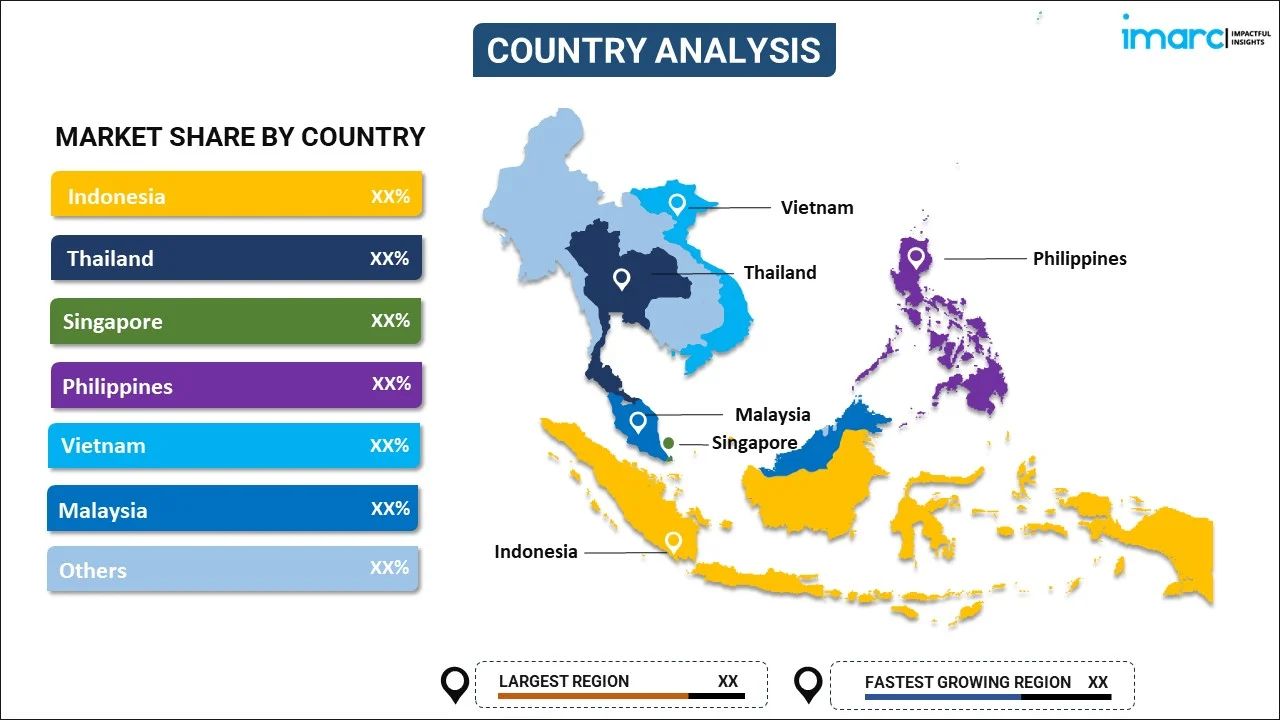
South East Asia Biopharmaceutical Market Report by Indication (Autoimmune Diseases, Oncology, Metabolic Disorders, and Others), Class (Recombinant Proteins, Monoclonal Antibodies, Purified Proteins), and Country 2025-2033
Market Overview:
The South East Asia biopharmaceutical market size is projected to exhibit a growth rate (CAGR) of 7.84% during 2025-2033. The rise in healthcare spending, the demographic shift towards an aging population, the increasing government initiatives and policies, the escalating incidence of chronic diseases, and rapid advancements in biotechnology and research are some of the factors propelling the market.
|
Report Attribute
|
Key Statistics
|
|---|---|
|
Base Year
|
2024 |
|
Forecast Years
|
2025-2033 |
|
Historical Years
|
2019-2024
|
| Market Growth Rate (2025-2033) | 7.84% |
A biopharmaceutical, often referred to as a biologic or biological drug, is a medicinal product derived from living organisms or their cellular components. Unlike traditional pharmaceuticals synthesized through chemical processes, biopharmaceuticals are produced using advanced biotechnological methods. These drugs are at the forefront of medical innovation, offering targeted and often highly specific therapeutic interventions for various diseases and medical conditions. The primary sources for biopharmaceuticals include proteins, nucleic acids, and other complex biomolecules. These can be engineered or modified to mimic or enhance natural biological processes within the body. Common examples of biopharmaceuticals include monoclonal antibodies, vaccines, gene therapies, and recombinant proteins. One key characteristic of biopharmaceuticals is their ability to act on specific cellular or molecular targets, enabling a more precise and personalized approach to treatment. This targeted nature often results in reduced side effects compared to traditional pharmaceuticals. The production of biopharmaceuticals involves intricate bioprocessing techniques, utilizing living cells, such as bacteria, yeast, or mammalian cells, as "factories" to manufacture the desired therapeutic proteins or compounds. This biotechnological manufacturing process requires stringent quality control to ensure the safety, efficacy, and purity of the final product. Biopharmaceuticals have significantly advanced medical treatments, providing breakthroughs in areas like oncology, autoimmune disorders, and rare diseases. Their complex nature and the sophisticated technology involved in their development contribute to their position as a cutting-edge and rapidly evolving sector within the pharmaceutical industry, addressing unmet medical needs and driving advancements in personalized medicine.
South East Asia Biopharmaceutical Market Trends:
The market in South East Asia is majorly driven by increasing healthcare awareness and rising disposable incomes. As individuals become more health-conscious, there is a growing demand for advanced and personalized treatments offered by biopharmaceuticals. Furthermore, government initiatives and investments in healthcare infrastructure play a pivotal role in driving the market. Governments across the region are prioritizing healthcare development, implementing policies that promote research, innovation, and accessibility to cutting-edge biopharmaceutical treatments. Supportive regulatory frameworks and incentives encourage both local and international pharmaceutical companies to invest in the region, fostering market growth. Besides, the escalating aging population in South East Asia is a key driver for the biopharmaceutical market. With an increase in life expectancy, there is a higher prevalence of age-related diseases and chronic conditions. Biopharmaceuticals, with their targeted and precise mechanisms of action, are well-suited to address the specific healthcare challenges associated with aging, contributing to the rising demand for these advanced therapies. Moreover, the region's susceptibility to infectious diseases and emerging health threats also fuels the demand for biopharmaceuticals. As South East Asia faces periodic outbreaks and public health crises, there is an emphasis on the development of vaccines and biologics to prevent and manage these infectious diseases. The COVID-19 pandemic, in particular, has underscored the importance of biopharmaceuticals in responding to global health emergencies. Additionally, the growing collaborations and partnerships between local and international pharmaceutical companies, research institutions, and healthcare providers further drive market growth. These collaborations facilitate knowledge exchange, technology transfer, and the development of region-specific biopharmaceutical solutions. Rapid advancements in biotechnology and research capabilities in the region contribute to the discovery and development of novel biopharmaceuticals, stimulating market innovation.
South East Asia Biopharmaceutical Market Segmentation:
IMARC Group provides an analysis of the key trends in each segment of the market, along with forecasts at the regional and country level for 2025-2033. Our report has categorized the market based on indication and class.
Indication Insights:

- Autoimmune Diseases
- Oncology
- Metabolic Disorders
- Others
The report has provided a detailed breakup and analysis of the market based on the indication. This includes autoimmune diseases, oncology, metabolic disorders, and others.
Class Insights:
- Recombinant Proteins
- Monoclonal Antibodies
- Purified Proteins
A detailed breakup and analysis of the market based on the class have also been provided in the report. This includes recombinant proteins, monoclonal antibodies, and purified proteins.
Country Insights:

- Indonesia
- Thailand
- Singapore
- Philippines
- Vietnam
- Malaysia
- Others
The report has also provided a comprehensive analysis of all the major regional markets, which include Indonesia, Thailand, Singapore, Philippines, Vietnam, Malaysia, and Others.
Competitive Landscape:
The market research report has also provided a comprehensive analysis of the competitive landscape. Competitive analysis such as market structure, key player positioning, top winning strategies, competitive dashboard, and company evaluation quadrant has been covered in the report. Also, detailed profiles of all major companies have been provided.
South East Asia Biopharmaceutical Market Report Coverage:
| Report Features | Details |
|---|---|
| Base Year of the Analysis | 2024 |
| Historical Period | 2019-2024 |
| Forecast Period | 2025-2033 |
| Units | Billion USD |
| Scope of the Report | Exploration of Historical Trends and Market Outlook, Industry Catalysts and Challenges, Segment-Wise Historical and Future Market Assessment:
|
| Indications Covered | Autoimmune Diseases, Oncology, Metabolic Disorders, Others |
| Classes Covered | Recombinant Proteins, Monoclonal Antibodies, Purified Proteins |
| Countries Covered | Indonesia, Thailand, Singapore, Philippines, Vietnam, Malaysia, Others |
| Customization Scope | 10% Free Customization |
| Post-Sale Analyst Support | 10-12 Weeks |
| Delivery Format | PDF and Excel through Email (We can also provide the editable version of the report in PPT/Word format on special request) |
Key Questions Answered in This Report:
- How has the South East Asia biopharmaceutical market performed so far and how will it perform in the coming years?
- What has been the impact of COVID-19 on the South East Asia biopharmaceutical market?
- What is the breakup of the South East Asia biopharmaceutical market on the basis of indication?
- What is the breakup of the South East Asia biopharmaceutical market on the basis of class?
- What are the various stages in the value chain of the South East Asia biopharmaceutical market?
- What are the key driving factors and challenges in the South East Asia biopharmaceutical?
- What is the structure of the South East Asia biopharmaceutical market and who are the key players?
- What is the degree of competition in the South East Asia biopharmaceutical market?
Key Benefits for Stakeholders:
- IMARC’s industry report offers a comprehensive quantitative analysis of various market segments, historical and current market trends, market forecasts, and dynamics of the South East Asia biopharmaceutical market from 2019-2033.
- The research report provides the latest information on the market drivers, challenges, and opportunities in the South East Asia biopharmaceutical market.
- Porter's five forces analysis assist stakeholders in assessing the impact of new entrants, competitive rivalry, supplier power, buyer power, and the threat of substitution. It helps stakeholders to analyze the level of competition within the South East Asia biopharmaceutical industry and its attractiveness.
- Competitive landscape allows stakeholders to understand their competitive environment and provides an insight into the current positions of key players in the market.
Need more help?
- Speak to our experienced analysts for insights on the current market scenarios.
- Include additional segments and countries to customize the report as per your requirement.
- Gain an unparalleled competitive advantage in your domain by understanding how to utilize the report and positively impacting your operations and revenue.
- For further assistance, please connect with our analysts.
 Inquire Before Buying
Inquire Before Buying
 Speak to an Analyst
Speak to an Analyst
 Request Brochure
Request Brochure
 Request Customization
Request Customization




.webp)




.webp)












